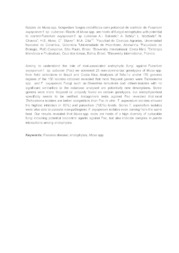Raízes de Musa spp. hospedam fungos endofíticos com potencial de controle de Fusarium oxysporum f. sp. cubense.
Raízes de Musa spp. hospedam fungos endofíticos com potencial de controle de Fusarium oxysporum f. sp. cubense.
Summary: Aiming to understand the role of root-associated endophytic fungi against Fusarium oxysporum f. sp. cubense (Foc) we screened 25 non-commercial genotypes of Musa spp. from field collections in Brazil and Costa Rica. Analyses of Tefa-1? and/or ITS genome regions of the 150 isolates obtained revealed that most frequent genera were Trichoderma spp. and F. oxysporum. Fungi such as Gloeotinia temulenta and others isolates with no significant similarities to the database analysed are potentially new descriptions. Some genera were more frequent or uniquely found on certain genotypes, but endophyte-host specificity needs to be verified. Antagonism tests against Foc revealed that most Trichoderma isolates are better competitors than Foc in vitro. T. asperellum isolates showed the highest inhibition (> 80%) and parasitism (100%) levels. Some T. asperellum isolates were also able to parasite non-pathogenic F. oxysporum isolates even coming from the same host. Our results revealed that Musa spp. roots are hosts of a high diversity of culturable fungi including potential biocontrol agents against Foc, but also indicate complex in planta interactions among endophytes.
Publication year: 2016
Types of publication: Abstract in annals or event proceedings
Unit: Embrapa Environment
Keywords: Musa, Panama disease, endophytes
Observation
Some of Embrapa's publications are published as ePub files. To read them, use or download one of the following free software options to your computer or mobile device. Android: Google Play Books; IOS: iBooks; Windows and Linux: Calibre.
Access other publications
Access the Agricultural Research Database (BDPA) to consult Embrapa's full library collection and records.
Visit Embrapa Bookstore to purchase books and other publications sold by Embrapa.

